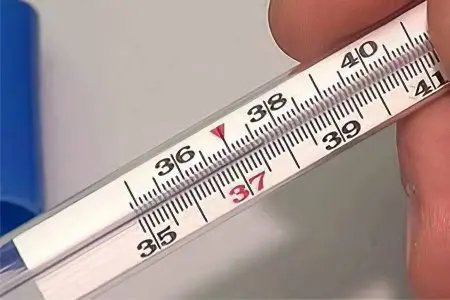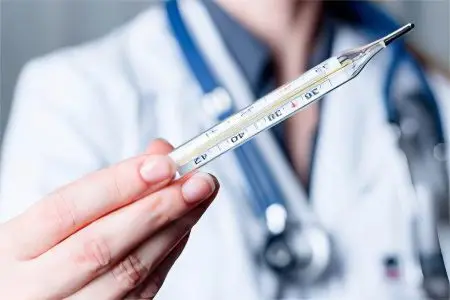Contents

Body temperature 37-37,5 ° C is called subfebrile temperature. Such marks on the thermometer can be observed quite often. Sometimes subfebrile body temperature indicates quite serious diseases, and sometimes it is simply the result of an error in the measurements.
If a temperature of 37 °C persists for a long period of time, it is necessary to seek the advice of a specialist. Only a doctor can determine whether such an increase in temperature is a variant of the norm or indicates the presence of any pathology.
How to measure body temperature correctly?

In humans, body temperature cannot always remain at the same mark. During the day and night, it can rise and fall, which is quite normal. In this case, the person will not experience any signs of illness. A cause for concern should be a prolonged increase in temperature to 37 ° C.
The following options for body temperature in humans are possible:
A mark on the thermometer below 35,5 ° C is a low body temperature.
The mark on the thermometer fluctuates between 35,5-37 ° C – normal body temperature.
The mark on the thermometer is 37,1-38 ° C (subfebrile condition) or more than 38 ° C – elevated body temperature.
Some doctors tend to believe that a body temperature in the range of 37-37,5 ° C is a variant of the norm. As subfebrile body temperature, they consider indicators on a thermometer from 37,5 to 38 ° C.
Some facts about body temperature that everyone should know:
Statistics indicate that for most people, a body temperature of 37 ° C is the norm. Although it is generally accepted that a temperature of 36,6 ° C is normal.
In one person, during the day, body temperature can fluctuate within 0,5 ° C or more, which is also a variant of the norm.
In the morning, the body temperature is always lower, and in the evening it can rise to 37 ° C.
During sleep, body temperature can drop to 36 ° C. The lowest rate is observed between 4 and 6 o’clock in the morning. If in the morning the body temperature is 37 ° C, this may indicate some kind of disease.
Starting from 16 p.m., a person’s body temperature may rise. For some people, a temperature of 37,5 in the evening is a variant of the norm.
In older people, body temperature is usually lower, and its daily jumps are not so pronounced.
The age of a person is of no small importance in determining the norm and pathology at different body temperatures. So, a temperature of 37 ° C in the evening in children is normal. The same data for the elderly is a pathology.
Body temperature can be measured in the following places:

Most often, people measure body temperature in the armpit. Although this is the most common method for determining body temperature, it is also the most uninformative. The data obtained can be affected by temperature and humidity, as well as other factors. In some cases, during the process of measuring body temperature, its reflex jump is observed. It may be related to the person’s anxiety. If body temperature is measured in the mouth or in the rectum, the error in the indicators will be minimal.
If body temperature is measured in the oral cavity, then one should be prepared for the fact that its values will be 0,5 ° C higher than in the armpit.
With the rectal method of measuring body temperature, the indicators will be 1 degree higher compared to body temperature in the armpit and 0,5 degrees higher than in the oral cavity.
It is possible to measure body temperature in the ear canal, and the data obtained will be as accurate as possible. However, a special device is required to perform measurements, therefore, at home, body temperature in the ear is not measured.
If body temperature is measured in the anus or in the mouth, then mercury thermometers must be abandoned. For this purpose, only an electronic thermometer is suitable. It is convenient to use a special thermometer-dummy when measuring body temperature in infants.
A body temperature of 37,1-37,5 ° C may be the result of measurement errors, or indicate any pathology. Only a doctor can determine this.
If a temperature of 37 is the norm?

When you see a temperature of 37-37,5 ° C on the thermometer, you should not panic. It is possible that such indicators are measurement errors.
To minimize the possibility of error, it is necessary to observe the following rules when measuring body temperature:
At least half an hour must pass from the moment of physical activity of a person. The state should be relaxed and calm. Often, in children after active and outdoor games, the body temperature rises to a mark of 37-37,5 ° C.
It is possible that the child’s body temperature rises after intense crying or screaming.
It is best to take measurements at the same time. It should be remembered that the body temperature is lower in the morning and higher in the evening.
The armpit must be absolutely dry during the measurement of body temperature.
You should not measure body temperature in the mouth if a person has just eaten or consumed hot drinks, if he has shortness of breath or nasal breathing is difficult, if he has just smoked.
Indicators of rectal thermometry can be increased by 1-2 degrees after taking a hot bath, or after physical activity.
A temperature of 37 ° C can be observed on the thermometer if the person has recently eaten, played sports or received other physical activity, suffered stress, is tired or is in a state of excitement. It is possible to increase the indicators after a long stay in the sun, when you are in a closed, stuffy room, where there is high humidity. Dry air and elevated ambient temperature affect body temperature.

It is possible that a temperature of 37 ° C is the result of a malfunction of the measuring device, which is very important for electronic thermometers, which often give a significant error. If the device has high readings, one of the family members should measure the body temperature, it is possible that it will also be higher than the usual values. It is good if the house has a mercury thermometer. However, it is not always possible to measure body temperature with a mercury device, for example, if we are talking about a small child.
To minimize the risk of error, it is necessary to measure the body temperature of an adult first with a mercury device, and then with an electronic one. After that, you should compare the indicators.
A body temperature of 37 ° C may be a normal variant under the following conditions:
It is possible to increase the temperature to 37 ° C against the background of physical activity, after suffering an emotional shock, with chronic fatigue.
Fluctuations in body temperature in women occur depending on the phase of the menstrual cycle. An increase in temperature is observed after ovulation (17-25 days of the cycle). In this case, the basal temperature may be higher than 37,3 ° C.
Menopause can also affect body temperature. So, the mark on the thermometer will rise during the so-called “tides”.
For infants (up to a month), a temperature of 37-37,5 is normal, since the processes of thermoregulation at this age are not yet perfect. Most often, this body temperature is observed in children born prematurely.
For pregnant women, a temperature of 37,2-37,5 is also normal. Most often, such an increase is observed in the early stages of bearing a child, although it can persist until the very birth of the baby.
During lactation, a temperature of 37 ° C is normal. Most often, such indicators are observed during the flow of milk. However, a woman should carefully monitor her condition. If the body temperature rises to febrile levels and this process is accompanied by chest pains, then this may indicate the development of mastitis. In such a situation, medical assistance is needed.
Although all of the listed conditions do not pose a threat to human life and health, a specialist consultation about an increase in body temperature of 37 ° C will not be superfluous.
Causes of a pathological increase in body temperature

A temperature of 37-37,5 ° C may indicate a pathological process in the body.
A similar increase in body temperature is characteristic of the following diseases:
The presence of infection in the body: SARS, tuberculosis, intestinal infections, inflammation of the kidneys, bladder, etc.
Non-communicable diseases, including: stomach ulcer, rheumatoid arthritis, thyroiditis, lupus erythematosus, etc.
Infection of the body with parasites: helminthiases, toxoplasmosis, amoebiasis, etc.
Allergic reactions.
Pathologies requiring surgical intervention. There may be an increase in body temperature after surgery.
Oncological diseases, diseases on the background of immunodeficiency.
Diseases of the cardiovascular and nervous system, chronic respiratory and skin diseases.
other states of the body. So, body temperature can increase during teething in children, or be a post-vaccination reaction of the body.
A body temperature of 37-37,5 ° C may accompany the course of the following infectious processes in the body:
Diseases of the respiratory system. Most often, these are acute respiratory viral infections. If the disease is mild, then the body temperature will be kept in the range of 37-37,5 ° C. In parallel, a person develops rhinitis and cough, possibly an increase in lymph nodes, the appearance of pain in the lower back and throughout the body. It is possible that a temperature of 37 ° C indicates bronchitis of a chronic nature or inflammation of the maxillary sinuses. Subfebrile condition is often observed with pneumonia (pneumonia), especially if the causative agent of the disease is mycoplasma or chlamydia. Against the background of tuberculosis, an elevated body temperature may persist for many years, and until a certain point in time, other symptoms of the disease will be absent.
Diseases of the kidneys and urinary tract. A temperature of 37 ° C very often accompanies cystitis, but the patient will also experience other signs of inflammation of the bladder. Against the background of pyelonephritis, which arose for the first time, the temperature increase is more significant. However, a body temperature of 37 °C may accompany an exacerbation of chronic pyelonephritis.
Diseases of the digestive system of an infectious nature. It is possible that a person develops gastritis, an ulcer of the stomach or intestines. This will cause pain in the abdomen. If the body temperature rises to 37-37,5 ° C, and in parallel a person has diarrhea and vomiting, then most likely he has an intestinal infection or hepatitis.
Diseases of the genital area. In women, the temperature may rise to subfebrile marks against the background of vulvovaginitis or other inflammation of the genital organs. Abortions and curettage can cause a temperature jump to 37 ° C and above. Similar indicators are observed during exacerbation of prostatitis in men.
Diseases of the heart and blood vessels. Inflammation of the heart muscle of an infectious nature may be accompanied by an increase in body temperature. In parallel, the patient will experience shortness of breath, edema and cardiac arrhythmias will appear.
The presence in the body of a focus of chronic infection. A temperature of 37,2 degrees may indicate tonsillitis, adenoiditis, prostatitis, or other pathology of a chronic nature. As a rule, after the elimination of the focus of inflammation, the body temperature returns to normal.
Diseases of children. Chickenpox is characterized by the appearance of a rash and an increase in body temperature up to 37 ° C and above. Similar symptoms accompany measles and rubella. As a rule, rashes cause discomfort to the child and are accompanied by itching. Sometimes a body temperature of 37 ° C and above can indicate very serious diseases, including: blood poisoning (sepsis), inflammation of the meninges (meningitis). Therefore, a doctor’s consultation is necessary.

Sometimes after an infection, a temperature of 37 ° C persists for a long time. Doctors call this condition “temperature tail”. This situation can be observed for several weeks and even months. There is no need for any specific treatment. The temperature tail will pass on its own after a while.
However, in a situation where a person has a runny nose and cough against a background of a temperature of 37 ° C, you should consult a doctor. Most likely, the disease was not fully treated and there was a relapse. Or a new infection has entered the body.
A temperature of 37 ° C and above can indicate helminthiasis in a child. Most often, children suffer from pinworms and ascaris. In parallel, there are symptoms such as: abdominal pain, alternating diarrhea and constipation, allergic reactions.
Other causes of fever in a child:
Post-vaccination reaction;
Overheating of the body;
Teething.

The appearance of teeth is very often accompanied by a body temperature of 37-37,5 ° C. In this case, taking any drugs is not required, you just need to monitor the condition of the child. As a rule, above 38,5 ° C, body temperature does not rise during teething.
Temperatures of 37°C or higher may rise after vaccine administration. If there is an impressive jump, then you can give the child an antipyretic drug. Young children are more susceptible to overheating than adults, so a temperature of 37 °C can be observed when the baby is overwrapped. Moreover, such an increase in body temperature can be very dangerous and lead to heat stroke. In such a situation, it is important to cool the child as quickly as possible by removing his clothes.
Inflammatory processes of a non-infectious nature can also lead to an increase in body temperature. Moreover, almost all diseases are accompanied by other symptoms. So, if a person has a temperature of 37 ° C and diarrhea with blood, then this most likely indicates the development of Crohn’s disease or ulcerative colitis. A disease such as systemic lupus erythematosus is accompanied by a body temperature of 37 ° C, which manifests itself several months before the onset of the first symptoms of the disease.
Some allergic reactions of the body may be accompanied by an increase in body temperature, such as hives and atopic dermatitis. In bronchial asthma, a body temperature of 37 ° C is combined with shortness of breath and breathing difficulties.
It is possible that a temperature of 37 ° C indicates diseases of the following systems:
Damage to the cardiovascular system:
Vegetative dystonia. At the same time, the body temperature rises to 37 ° C and above, and the patient also has headaches, blood pressure rises.
Hypertension, hypertensive crisis.
The defeat of the respiratory system, namely, chronic obstructive pulmonary disease (COPD).
Damage to the digestive system. A temperature of 37 ° C may accompany pancreatitis, gastritis, non-infectious hepatitis, esophagitis, etc.
Damage to the nervous system:
Hemorrhages, tumors of the brain and spinal cord, trauma.
In young women with dystonia, a temperature of 37 °C indicates thermoneurosis.
Kidney disease. Urolithiasis, glomerulonephritis, nephropathy of a dysmetabolic nature may be accompanied by a temperature of 37 °C.
The defeat of the endocrine system, namely: Addison’s disease and hyperthyroidism.
Diseases of the immune system, blood diseases:
Iron deficiency anemia and other blood pathologies.
Oncological diseases, diseases on the background of immunodeficiency.
Damage to the reproductive system. A temperature of 37 ° C may accompany conditions such as: uterine fibroids, ovarian cysts, etc.
Cancer diseases are characterized by a temperature of 37-37,5 ° C, which persists for a long time. In parallel, the patient begins to lose weight, his appetite suffers, weakness increases. Depending on where the tumor is located, functional disorders of certain organs will be observed.
After surgery, a temperature of 37-37,5 °C is normal. It can persist for a long time, which depends on the severity of the operation and on the individual characteristics of the human body. Sometimes an increase in body temperature to subfebrile values is observed after laparoscopy or after other diagnostic procedures.
Diagnosis at a temperature of 37-37,5 ° C

Long-term preservation of a temperature of 37-37,5 ° C is a reason to consult a doctor. First you need to go to an appointment with a therapist if we are talking about an adult, or to a pediatrician if we are talking about a child. Pregnant and lactating women should definitely visit a gynecologist.
A temperature of 37-37,5 ° C is a reason for undergoing the following examinations:
Blood donation for general and biochemical analysis.
Urine for general analysis.
Passage of ultrasound of the abdominal cavity, pelvic organs.
Performing ECG and ultrasound of the heart.
It is possible to conduct a blood test for tumor markers, antibodies, hormones, etc.
These studies are classic, if such a need arises, then the patient is referred for a CT scan or MRI, cerebrospinal fluid puncture, etc. The doctor must definitely pay attention to other symptoms that accompany an increase in body temperature.
As necessary, the therapist refers the patient to a consultation with a specialist.
What to do when the temperature rises to 37-37,5 ° C?

Go see your therapist first. Very often, we are simply not able to notice certain symptoms, and the doctor can easily identify them and be able to diagnose the disease.
Depending on the identified disease, the doctor may prescribe antibiotics, antiviral drugs, hormonal agents, cytostatics, infusion solutions.
When to take antipyretics and when not to take them?
Do not take antipyretic drugs at a temperature of 37-37,5 ° C. Removing a symptom, you can postpone the examination for a long time and start the disease, which, of course, is harmful to health. They are used only to reduce the temperature of 38,5 ° C or more.
Although there are exceptions to this rule. So, it is necessary to lower the temperature of 37,5 ° C in women in the third trimester of pregnancy.
Antipyretic drugs should be given to children who have previously had febrile convulsions. Indications for a decrease in temperature of 37,5 ° C are pathologies of the lungs, heart and nervous system, which can progress even with such a slight increase in the marks on the thermometer.
It should be understood that the use of antipyretic drugs can lead to difficulties in diagnosing diseases, as well as to the development of side effects.
Note
In any situation, you need to pay attention to the following points:
Eliminate the possibility of error during the measurement of body temperature.
Measure body temperature with 2 thermometers.
Think about whether a temperature of 37 ° C is not a variant of the norm. For example, if a woman is carrying a child and is in the early stages of pregnancy, but at the same time her body temperature rises and there are no signs of illness, then this is most likely normal.
As a rule, when a disease becomes the cause of an increase in body temperature, then after its elimination, the values uXNUMXbuXNUMXbcome back to normal.
When should you call a doctor?
You should immediately call a doctor in the following situations:
Body temperature exceeds 38 °C.
In addition to a temperature of 37 ° C, symptoms such as chest pain, diarrhea and vomiting, urination disorders, severe cough, etc.
You should also consult with a specialist if there are any suspicions of health problems.
Preservation of subfebrile condition for several months after pneumonia is a normal reaction of the body. This condition goes away on its own without the use of any special means. But to speed up this process, you can drink vitamin C and D, zinc.
[Video] The main causes of a temperature of 37-37,5, and what to do about it?









